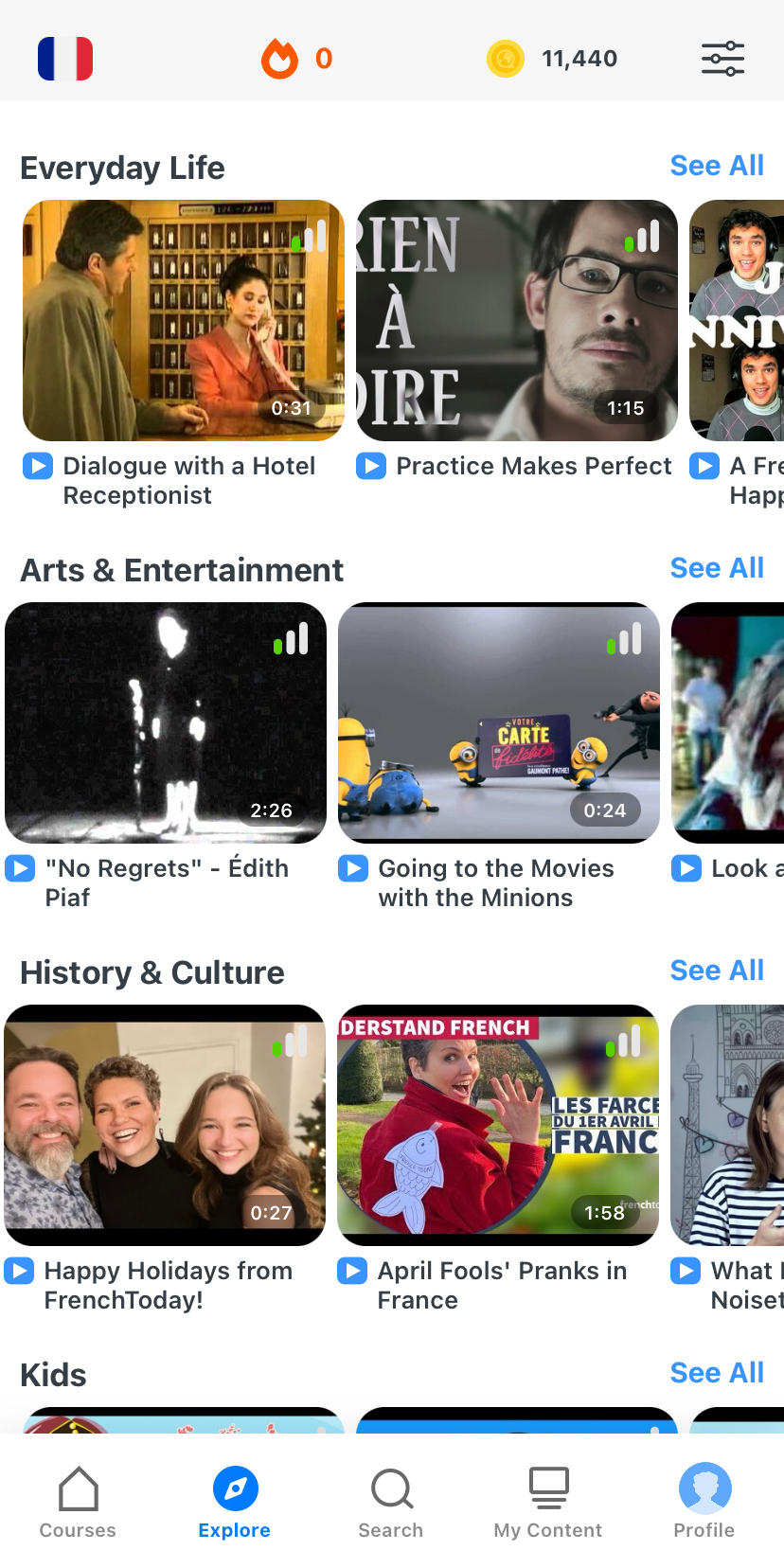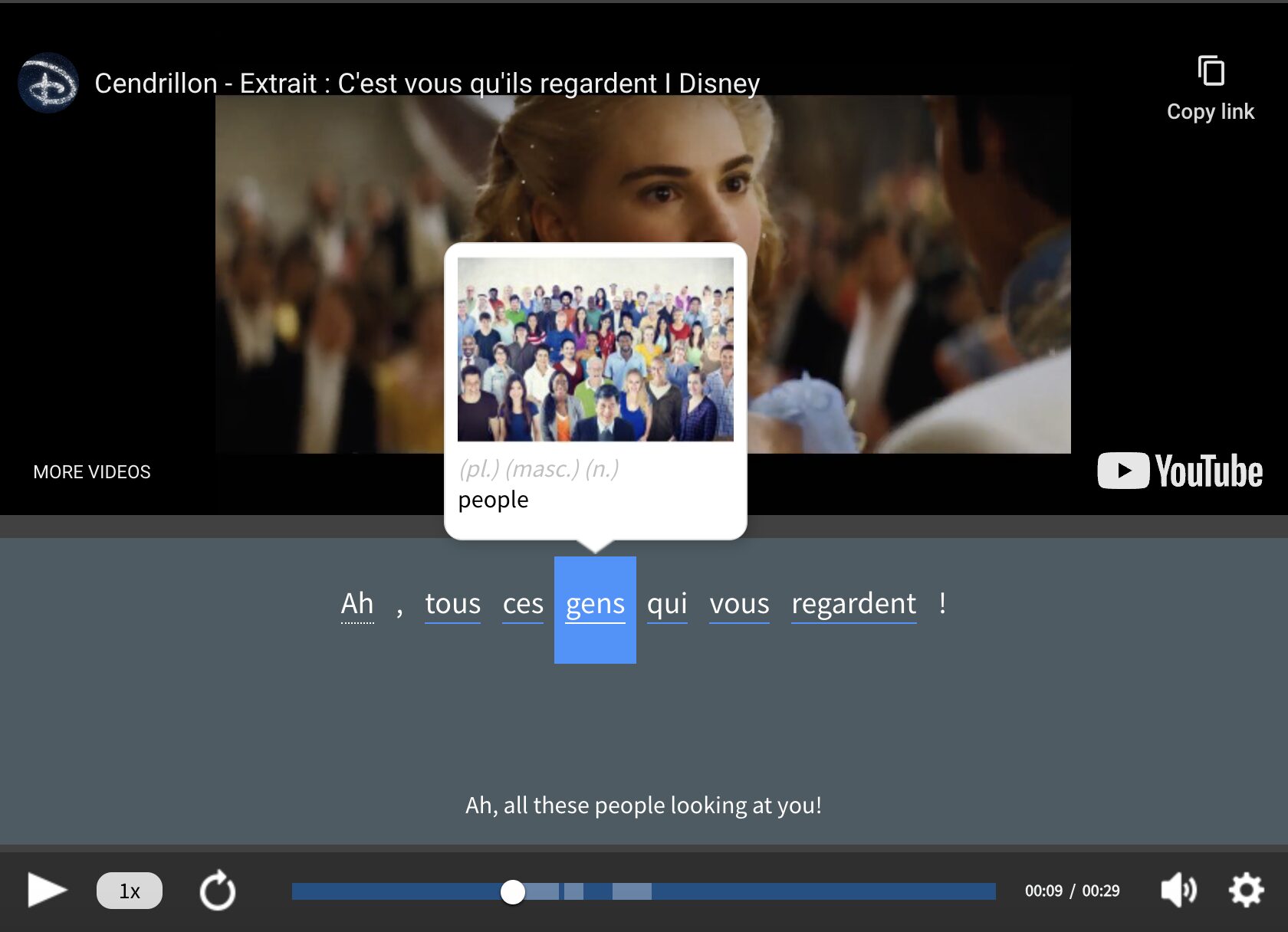The Absolute Guide to French Personal and Impersonal Pronouns

Pronouns are an important part of all languages and are used in conversations to replace people, places, things and phrases.
In French, there are two groups of pronouns: personal and impersonal pronouns. Read on to learn more about all of the different types of French pronouns as well as how to use them correctly.
If you’re more of a visual learner, then you may want to check out our video on French pronouns from the FluentU French YouTube channel:
Download: This blog post is available as a convenient and portable PDF that you can take anywhere. Click here to get a copy. (Download)
Personal Pronouns in French
Personal pronouns simply replace the who or what in a sentence. They will always agree with the person or thing they represent. For example:
J‘ai (1) un super-pouvoir. Je peux mettre des pronoms à la place des choses. (I have a superpower. I can replace people with pronouns.)
Je les utilise (2) pour mes amis et mes parents. (I use them for my friends and my parents.)
Quand je parle avec eux (3), je leur (4) donne un ZAP et ils s‘en vont ! (5). (When I speak with them, I give them a zap and they leave!)
These pronouns may look insignificant but, if used correctly, they can vastly improve your sentence structure.
1. Personal Subject Pronouns
Personal subject pronouns are key to conjugation. Subject pronouns replace the subject of the sentence. In French these are:
je/j’ — I
tu — you
il/elle/on — he/she/one
nous — we
vous — you formal, you all
ils/elles — they
Example:
- John était en retard. Il était en retard. — John was late. He was late.
2. Direct Object Pronouns
To understand the uses of direct object pronouns (D.O. pronouns for short), you first need to know that a direct object is the who or what that the verb affects.
For an English example, the direct object would be “article” in the following sentence: “You are reading an article.” That’s because the reading is happening to the article. Thus, a direct object pronoun would replace this direct object.
Here are the D.O. pronouns in French:
me/m’ — first person singular
te/t’ — second person singular
le/la/l’ — third person singular
nous — first person plural
vous — second person plural
les — third personal plural
Example 1:
- Je mange le gâteau. Je le mange. — I am eating the cake. I am eating it.
Since le gâteau is third person singular, we replace it with le and place the pronoun before the verb.
Example 2:
- Tu aimes les films français. Tu les aimes. — You like French films. You like them.
Pro tip: The pronoun must agree with the gender and quantity of what we replace.
3. Stressed Pronouns
These pronouns are useful and versatile. Most commonly, they’re used to emphasize a person in a sentence.
moi — first person singular
toi — second person singular
lui/elle/soi — third person singular
nous — first person plural
vous — second person plural
eux/elles — third person plural
There are eleven different ways in which stressed pronouns can be used, all with the same general idea in their function: stressing the person. Here are the most common ways:
- After C’est or Ce sont.
C’est toi qui laves la salle de bain. — It’s you who is washing the washroom.
- When there’s more than one subject in a sentence.
Michel et moi avons fait du shopping. — Michel and I went shopping.
- When asking questions.
Je suis content, et toi ? — I’m happy, and you?
- After prepositions.
Chez lui, sans elle — His house, without her.
- In forming comparisons.
Nous sommes plus rapides qu’eux. — We are faster than them.
- When indicating possession.
Cette tarte est à elle. — That pie belongs to her.
4. Indirect Object Pronouns
me/m’ — me
te/t’ — you
lui — him/her/one
nous — us
vous — you (plural)
leur — them
An indirect object is a person or animate object that are preceded by a preposition (à, de). As you may have noticed, the pronouns themselves are similar to D.O. pronouns.
Pro tip: Pay attention to the distinction between the third person singular or third person plural when you’re forming sentences with direct or indirect object pronouns. Use lui/leur for indirect object and le/la/les for direct object.
Examples:
- Je demande à ma mère. Je lui demande. — I ask my mom. I ask her.
- Je donne le cadeau aux enfants. Je le leur donne. — I am giving the gift to the kids. I am giving it to them.
Don’t worry if there are two pronouns, there’s a quick trick to remembering the order of multiple pronouns at the bottom of this post.
The key to choosing between using an indirect or direct object pronoun is whether or not there’s a preposition before the person or animate object. If yes, then it’s an indirect object. Just think: since there’s a preposition, you’re going indirectly to the noun.
5. Reflexive Pronouns
For English speakers, reflexive pronouns and reflexive verbs don’t always seem logical and often look redundant. However, in French they’re essential.
me/m’ — myself
te/t’/toi — yourself
se/s’ — himself/herself/oneself
nous — ourselves
vous — yourselves
se/s’ — themselves
me, te, se, nous and vous are the pronouns. You’ll see them used with reflexive (or pronominal) verbs as shown below.
Examples:
- se laver — to wash oneself
- se casser — to break (a body part)
- s’habiller — to get dressed
We conjugate them with the help of our reflexive pronouns:
Je me lave.
Tu te laves.
Il se lave.
Nous nous lavons.
Vous vous lavez.
Ils se lavent.
(I wash myself, you wash yourself, etc.)
Remember that reflexive pronouns always agree with the subject and are used with reflexive verbs.
A great way to identify when and how to use French pronouns is to immerse yourself in French media and see the pronouns used in context by native French speakers. Here’s an example of a French media clip where various pronouns are used:
You can find more clips like this on the FluentU program.
FluentU takes authentic videos—like music videos, movie trailers, news and inspiring talks—and turns them into personalized language learning lessons.
You can try FluentU for free for 2 weeks. Check out the website or download the iOS app or Android app.
P.S. Click here to take advantage of our current sale! (Expires at the end of this month.)
Impersonal Pronouns in French
In the example below, you’ll be able to see some of the most common impersonal pronouns in French, such as que (that), qui (that/who) and ce (it), as well as a couple of adverbial pronouns (en and y) which we will also cover in this section:
Je sais que je peux remplacer des choses qui ne sont ni COD ni COI. (I know that I can replace things that are neither direct objects nor indirect objects.)
C’est mon super-pouvoir ! (It‘s my super-power!)
J’en trouve un et ZAP ! (I find one and ZAP!)
Il y a plusieurs pronoms que je peux utiliser. (There are several pronouns that I can use.)
6. Impersonal Subject Pronouns
- ce, il
In English, our impersonal subject pronoun is “it.” In French, you use ce or il. They can often be used interchangeably, but ce is more informal.
Examples:
- Il est possible que…
— It is possible that…
- C’est moi.
— It’s me.
- Il est nouveau.
— It is new.
- C’est fini ! — It’s finished!
7. Relative Pronouns
These pronouns connect dependent clauses with the main clauses. In other words, they connect the part of the sentence without a subject to the part of the sentence with a subject. There are five relative pronouns, all with their own special purpose.
- Que
Replaces the Direct Object in the dependent clause. It functions kind of the same as the word “that” in English. The major exception is that “that” is often optional in English and que is a must!
Example: Où est la chose que j’ai achetée hier ? — Where is the thing (that) I bought yesterday?
Here, que is referring to la chose (the thing) which is the direct object of the verb acheter (to buy).
- Qui
Replaces the subject (either person or thing) in the dependent clause, like the word “who” in English.
Example: Je voudrais un prof qui ne donne pas de devoirs. — I would like a teacher who doesn’t give homework.
Note that, this qui has nothing to do with people:
Cependant, le prof donne des devoirs qui nous aident à apprendre. — However, the teacher gives us homework that helps us learn.
Here, qui is referring to devoirs (homework) which is the subject of the verb aider (to help).
- Lequel/Laquelle/Lesquels/Lesquelles
Replaces an indirect object after a preposition.
If the noun is a person, you need to use the preposition + qui. There are some more advanced contractions using lequel that you may run into later on, but let’s stick to basics right now. Think of it as “which” in English.
Example: Je n’ai pas lu la lettre à laquelle tu as répondu. — I didn’t read the letter to which you responded.
- Dont
Replaces an object followed by de. The English equivalent is “whose” or “that.” It’s used often with phases like: parler de (speak of), avoir besoin de (to need) and avoir peur de (be scared of).
Example: Le pronom dont j’ai peur ! — The pronoun that I’m scared of!
- Où replaces a place. It’s also the question word for “where,” which makes it easy to remember.
Example: C’est là où j’ai mangé hier. — It’s where I ate yesterday.
It can also be used to replace a time.
Example: Mercredi, c’est le jour où je pars. — Wednesday, it’s the day that I leave.
8. Adverbial Pronouns
There are only two adverbial pronouns: y and en.
Y is used to replace à + a noun (often a place), while en is used to replace de + a noun or phrase.
En can also be used to replace quantities + a noun. These are very important pronouns, and you’ve probably heard them used in phrases such as Il y a… (There is…) and J’en ai un (I have one). Let’s have a look at some examples.
- Y
Examples:
Je voudrais aller à Paris becomes → Je voudrais y aller. — I would like to go to Paris. I would like to go there.
Il pense à l’été dernier becomes → Il y pense. — He thinks of last summer. He thinks of it.
Pro tip: Make sure you’re using y in instances of à + an object. Don’t confuse it with lequel (which is used to link clauses), or with lui/leur which is for indirect objects that are people or animate objects. If you have à + an inanimate object, then use y.
- En
Example:
Ma mère prépare des pâtes. Ma mère en prépare. — My mom is preparing some pasta. My mom is preparing some.
In addition, you can use en when a quantity word is involved.
Examples:
Il a beaucoup de bonbons. Il en a beaucoup.
— He has a lot of candy. He has a lot of it.
Elle a deux livres. Elle en a deux.
— She has two books. She has two of them.
Pro tip: You need the pronoun en when talking about quantities. For instance, you can’t say J’ai un. This simply means nothing, or will be taken as the beginning of a sentence J’ai un… livre (I have a… book). You need to squeeze en in there for your intended effect: J’en ai un (I have one).
9. Indefinite pronouns
These pronouns are unspecific words that can be used as the subject of a sentence, the object of a verb or as a preposition. Here are some examples:
d’autres
— others
chacun
/ chacune
— each one
certains
/ certaines
— certain ones
plusieurs
— several
quelque chose
— something
quelqu’un
— someone
tout
— everything
tout le monde
— everyone
Pro tip: Use the third person singular or plural when the subject is an indefinite pronoun and you’re conjugating verbs.
Now that you know about French pronouns, you’ll soon be speaking like a native and cutting out any repeated nouns!
Final pro tip: In a case of more than one pronoun used in a phrase, there’s a correct order to place them in. Try saying the pronouns to the tune of the French nursery rhyme “Frère Jacques” to help you remember them:
me, te, nous, vous
me, te, nous, vous
le, la, les
le, la, les
lui, leur
lui, leur
y
en
y
en
As you can see, there are many different types of French pronouns and using them will make expressing yourself in the language easier.
Now that you’ve learned French pronouns you can say things like, Je le lui ai donné (I gave it to him), with zero stress!
Download: This blog post is available as a convenient and portable PDF that you can take anywhere. Click here to get a copy. (Download)
And One More Thing...
If you like learning French at your own pace and from the comfort of your device, I have to tell you about FluentU.
FluentU makes it easier (and way more fun) to learn French by making real content like movies and series accessible to learners. You can check out FluentU's curated video library, or bring our learning tools directly to Netflix or YouTube with the FluentU Chrome extension.
One of the features I find most helpful is the interactive captions—you can tap on any word to see its meaning, an image, pronunciation, and other examples from different contexts. It’s a great way to pick up French vocab without having to pause and look things up separately.
FluentU also helps reinforce what you’ve learned with personalized quizzes. You can swipe through extra examples and complete engaging exercises that adapt to your progress. You'll get extra practice with the words you find more challenging and even be reminded you when it’s time to review!
You can use FluentU on your computer, tablet, or phone with our app for Apple or Android devices. Click here to take advantage of our current sale! (Expires at the end of this month.)











